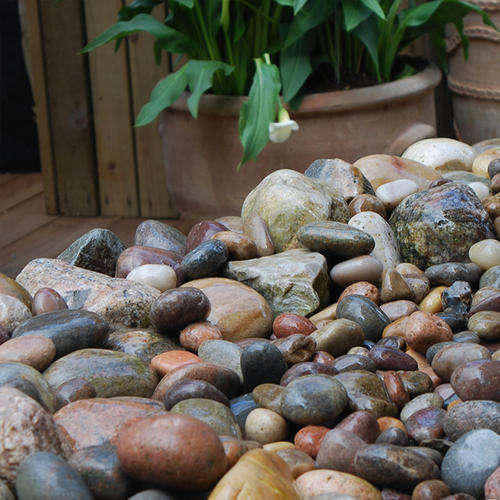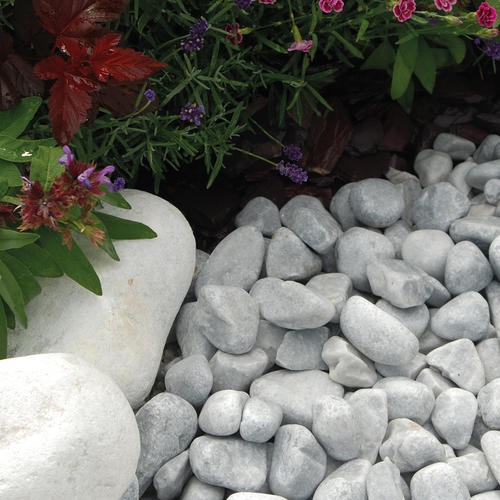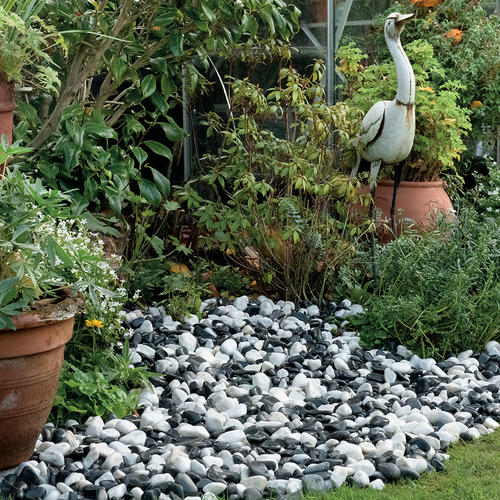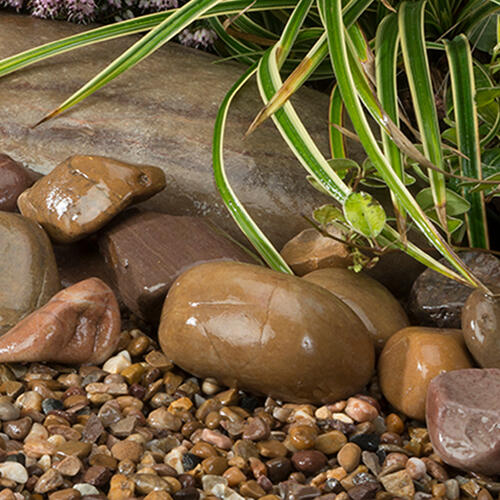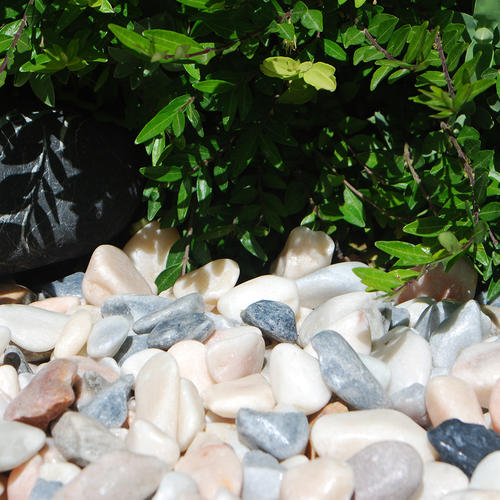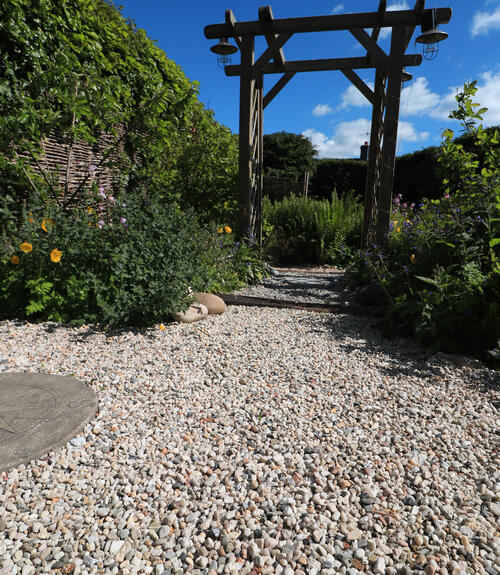Stone Zone's Cobbles & Pebbles Range
Stone Zone's Cobbles & Pebbles Range
There are numerous ways you can decorate your garden, but a simple but effective way is to use Cobbles and Pebbles; which will add colour, texture and dimension to your outdoor space. Here at Stone Zone, we take great pride in supplying a wide range of Cobbles and Pebbles that you can use around your garden to create borders, rockery centrepieces, or to enhance existing features. This will hopefully give you lots of inspiration to add some of these natural stones to your garden.
Cobbles and Pebbles in Your Garden
Creating features with cobbles and pebbles can add visual interest and texture to your garden or outdoor space. Here are some ideas for incorporating them into various features:
Pathways
Use cobbles to create sturdy and durable pathways throughout your garden.
Line the edges of the pathways with pebbles to define the borders and add a decorative touch.
Consider mixing different colours and sizes of cobbles and pebbles to create interesting patterns and designs along the pathways.
Borders and Edging
Create borders around flower beds, garden beds, or lawn areas using cobbles or larger stones.
Fill in the gaps between the cobbles with smaller pebbles to create a seamless transition between the edging and the surrounding landscape.
This can help prevent soil erosion and define the boundaries of different garden areas.
Water Features
Construct a pebble fountain or waterfall feature using cobbles and pebbles.
Stack cobbles to create a cascading effect, with water flowing between the gaps.
Surround the base of the fountain or waterfall with pebbles to enhance the natural look and provide a decorative border.
Rock Gardens
Build a rock garden using a combination of cobbles, pebbles, and larger rocks.
Arrange the cobbles and pebbles to create terraces or raised beds within the rock garden.
Plant low-maintenance succulents, alpine plants, or drought-tolerant species among the rocks to complete the look.
Dry River Beds
Create a dry river bed feature using cobbles and pebbles to mimic the look of a natural stream.
Arrange larger cobbles to define the edges of the river bed and create a winding path.
Fill the space between the cobbles with smaller pebbles to represent the riverbed and add texture.
Mosaic Art
Use cobbles and pebbles to create intricate mosaic designs on garden walls, stepping stones, or decorative panels.
Arrange the pebbles in patterns or images, and secure them in place with mortar or adhesive.
This can add a unique and personalized touch to your garden decor.
Accent Features
Incorporate cobbles and pebbles as decorative accents in garden pots, planters, or raised beds.
Use them to fill in the space around potted plants or as a top dressing to add visual interest.
Consider using coloured pebbles or cobbles to create eye-catching focal points within your garden.
By incorporating cobbles and pebbles into various features in your garden, you can create a cohesive and visually appealing outdoor space with natural charm and texture.
Create a Water Feature Using Cobbles and Pebbles
Creating a water feature with pebbles can add a serene and natural element to your garden or outdoor space. Here's a guide on how to create a simple pebble-based water feature:
Select a Location
Choose a suitable location for your water feature. Consider factors such as sunlight exposure, proximity to power sources (if using a pump), and visual impact within your garden.
Choose the Type of Water Feature
There are several types of water features you can create with pebbles, such as a pebble fountain, pebble pond, or pebble stream. Decide which type best suits your space and preferences.
Gather Materials
Pebbles: Select a variety of pebbles in different sizes, shapes, and colours to create visual interest.
Waterproof basin or container: Choose a container that is large enough to hold the water and sturdy enough to support the weight of the pebbles and any additional features.
Water pump (optional): If you want to create a fountain or flowing water feature, you'll need a water pump.
Tubing (if using a pump): Purchase tubing appropriate for your pump to circulate the water.
Prepare the Basin
Place the waterproof basin or container in the desired location.
If using a water pump, position it in the basin according to the manufacturer's instructions.
Run the tubing from the pump to the desired location for water flow.
Arrange the Pebbles
Start by placing larger pebbles at the bottom of the basin to create a stable foundation.
Layer smaller pebbles on top, gradually building up the desired height and shape for your water feature.
Experiment with different arrangements and patterns to achieve the look you want.
Consider incorporating other elements such as larger rocks, driftwood, or aquatic plants to enhance the natural feel of the water feature.
Add Water
Fill the basin with water, ensuring that the pump (if used) is fully submerged.
Test the pump to make sure it is functioning properly and adjust the flow rate as needed.
Finishing Touches
Once the water feature is complete, take some time to fine-tune the arrangement of pebbles and other elements.
Consider adding lighting around the water feature to create an ambience and highlight its beauty, especially at night.
Maintenance
Regularly clean the basin and pump to prevent algae growth and ensure optimal performance.
Keep an eye on the water level and top it up as needed to compensate for evaporation.
Remove any debris or fallen leaves from the water surface to maintain its clarity.
By following these steps, you can create a beautiful water feature using pebbles that add tranquillity and elegance to your outdoor space.
How to Maintain Cobbles and Pebbles
Maintaining cobbles and pebbles in your garden is essential to preserve their appearance and functionality over time. Here are some tips for effectively maintaining these stones.
Regular Cleaning
Sweep or rake the surface of the cobbles and pebbles regularly to remove debris, fallen leaves, and other organic matter.
Use a leaf blower or a gentle stream of water to clean hard-to-reach areas and dislodge stubborn dirt or debris.
Weed Control
Keep an eye out for weeds growing between the cobbles and pebbles, as they can detract from the appearance of your garden.
Pull out weeds by hand or use a garden hoe to remove them, taking care not to disturb the surrounding cobbles or pebbles.
Preventing Algae and Moss Growth
Algae and moss can thrive in damp and shaded areas, so ensure proper drainage and sunlight exposure to prevent their growth.
If algae or moss does appear, scrub the affected areas with a stiff brush and a solution of water and mild detergent or a commercial algae/moss remover.
You can also consider installing a layer of weed fabric in the bedding.
Repairing Displaced or Damaged Cobbles
Check for any displaced or damaged cobbles regularly and repair them promptly to maintain the integrity of your garden features.
Remove the affected cobble, level the base if necessary, and reposition the cobble. Ensure it is securely in place and level with the surrounding cobbles.
Replenishing Pebbles
Over time, pebbles may become displaced or lost due to erosion or other factors.
Periodically check the level of pebbles in your garden features and add more as needed to maintain a consistent appearance and fill any gaps.
Sealing
Consider applying a sealant to the cobbles and pebbles to enhance their appearance and protect them from staining and weather damage.
Choose a sealant specifically designed for outdoor use and follow the manufacturer's instructions for application.
Inspecting Drainage
Ensure that the drainage around your cobbles and pebbles is functioning properly to prevent water accumulation and potential damage.
Clear any debris or blockages from drainage channels or gutters to allow water to flow freely away from the area.
Seasonal Maintenance
Adjust your maintenance routine seasonally to address specific challenges such as fallen leaves in autumn or algae growth in spring.
Take proactive measures to protect your cobbles and pebbles during harsh weather conditions such as freezing temperatures or heavy rainfall.
By following these maintenance tips, you can keep your cobbles and pebbles in optimal condition and enjoy a beautiful and well-maintained garden for years to come.


